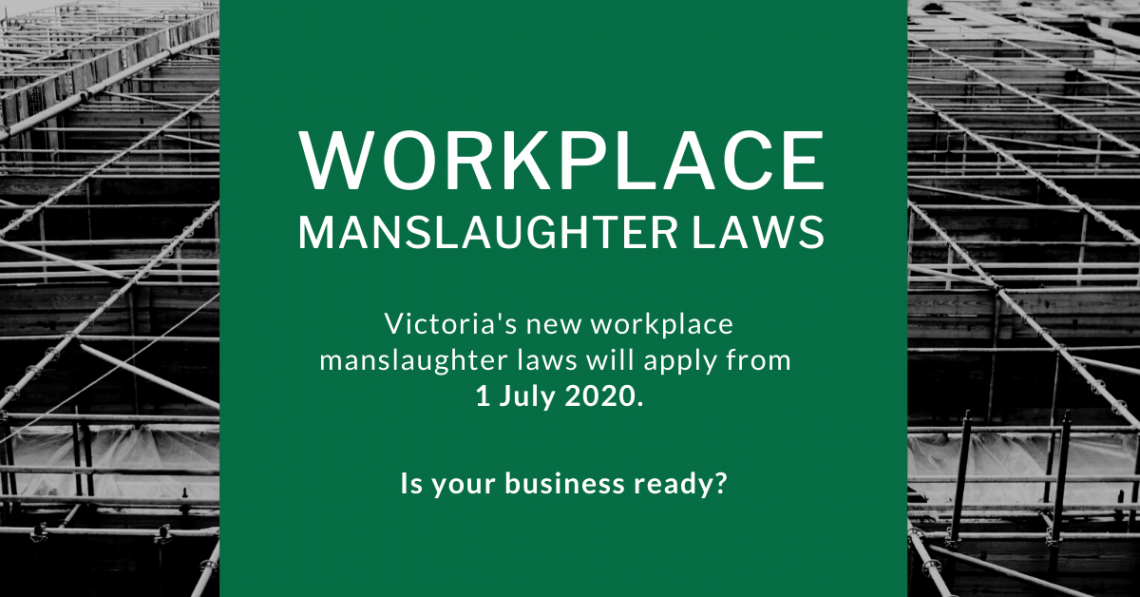25 June, 2020

Victoria will soon become the fourth Australian jurisdiction (following Queensland, the Australian Capital Territory and the Northern Territory) to introduce workplace manslaughter offences. The Workplace Safety Legislation Amendment (Workplace Manslaughter and other matters) Bill 2019 will become law in Victoria on 1 July 2020.
What are these new workplace manslaughter laws in Victoria?
An expansion of existing OHS legislation, the new laws criminalise negligence on the part of a Person Conducting a Business or Undertaking (PCBU) resulting in workplace death.
Under the existing Occupational Health and Safety (OHS) Act 2004 (VIC), employers must already “provide and maintain a working environment that is safe and free of risks to health, so far as is reasonably practicable”.
This duty of care will remain unchanged.
What will change, however, is the severity of the consequences for organisations and individuals found in criminal breach of the OHS Act.
The new criminal offences and substantially harsher penalties aim to prevent workplace death by sending a strong deterrent message to those with “significant power” within an organisation. The laws reinforce the fact that those with power have responsibilities to provide a safe and healthy workplace.
A person conducting a business or undertaking must be compliant with their OHS obligations or risk significant penalties in the event of a workplace death.
Here’s a snapshot:
- When: the legislation will apply from 1 July 2020.
- Who: the new laws will apply to those with “significant power” within an organisation. This includes a person, a body corporate, an unincorporated body or association or a partnership, including government entities and officers of these entities who hold duties under Part 3 of the OHS Act.
- Employees and volunteers are exempt.
- The new laws will be applicable to all businesses operating in Victoria, regardless of size.
- Penalties: if a PCBU is convicted of workplace manslaughter the following penalties apply:
- A maximum of 20 years imprisonment for individuals.
- A maximum fine of $16.5 million for body corporates.
I have “significant power” in my business. What do I need to do to ensure that I am compliant on 1 July?
Don’t be complacent. This is a timely reminder to review your OHS policies, procedures and practices to ensure your business is doing everything that is reasonably practicable to minimise risks in your workplace.
- Of all the risks facing your staff and those interacting with your business, what are the risks where death or serious injury is a probable outcome?
- What risk controls are presently in place to control those risks?
- Are those controls sufficient? Do they adequately reduce the risk and otherwise protect people?
If you don’t know the answers to those questions, then you must ask someone who does to work through them for you.
Lives depend on it.
As independent safety and ergonomics experts, Dohrmann Consulting routinely advises on safety compliance matters. We leverage the experience gained from regularly providing expert opinion and evidence in court, and in incident investigation, including forensic investigation of serious workplace incidents.
Of the thousands of workplace incidents and injuries (and unfortunately many deaths) that we’ve investigated, all could and should have been prevented.
What are some of the key risk management issues to consider again?
- Risk analysis (identify, assess, control and monitor risks): every task or activity within and around your workplace that involves a potential risk to health and safety, must be reviewed and addressed. Eliminate any risks which can be removed and minimise the risks which cannot.
- Safe systems of work: ensure you have the appropriate policies, procedures and practices in place to eliminate and mitigate risk. For example, controlling entry to high-risk areas and providing systems to prevent falls from heights.
- Communication and training: consult with employees on matters related to health or safety that directly affect or are likely to directly affect them. Ensure your policies, procedures and practices are communicated across your organisation. Employees should be trained to work safely.
- Safety culture: a positive safety culture can result in improved workplace health and safety and organisation performance. Review your organisation’s values, beliefs and attitudes towards safety within your organisation. Do you have a process to report safety incidents and encourage employees to report incidents, hazard or near misses? Do employees know where, when and how to report?
- Mental health: mental health is just as important as physical health. Do you have any procedures in place to manage risks relating to the mental health of your employees?
- Continuous improvement: ensure your organisation continuously monitors its safety policies, processes and procedures, and constantly seeks to reduce risk. Stay up to date with legislative developments in jurisdictions in which your organisation conducts business and understand how it could impact your organisation.
Further information about Victoria’s new workplace manslaughter laws and the OHS Act, can be found on the following websites:
- Victorian Legislation website at legistation.vic.gov.au
- WorkSafe Victoria website at worksafe.vic.gov.au








